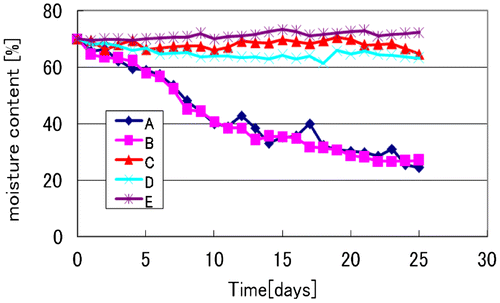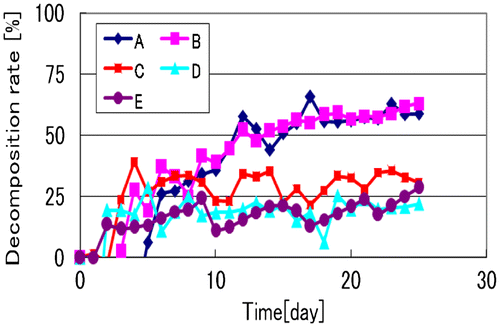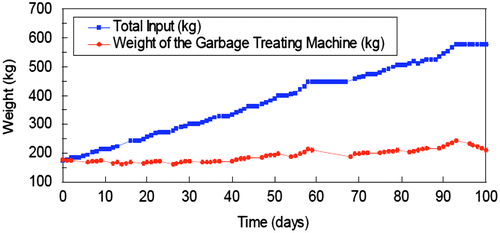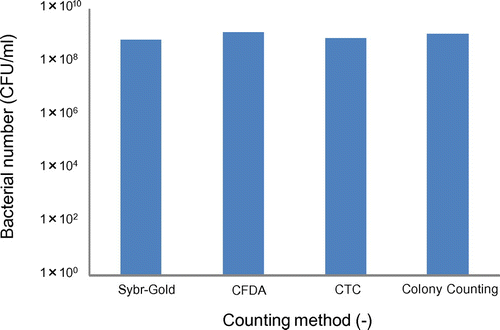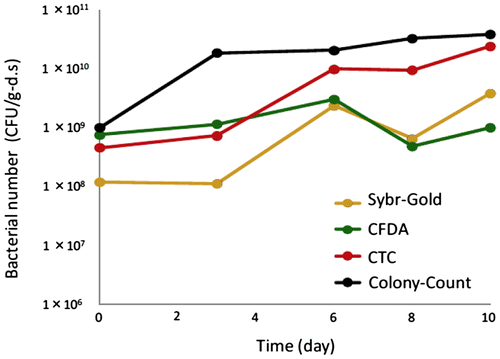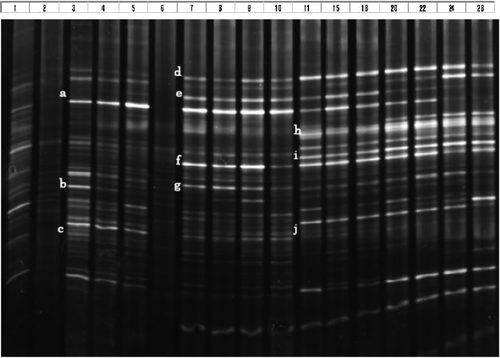Abstract
Since the garbage fraction of urban refuse causes many troubles and difficulties in treating and disposing of refuse, an effective treatment of the garbage fraction at an individual emission source would bring a variety of great advantages. Among many possible methods, the microbial decomposition type of garbage treatment system would be one of the most anticipated options. For this purpose we have developed a useful domestic garbage treatment system using micro-organisms with little energy consumption called “static type”. In contrast with the conventional type of garbage treatment devices, which had a hard reactor wall and were always equipped with an internal structure for agitation as well as aeration, our system has a very simple structure and a soft outer wall with high breathability, and mixing operation is only performed once a day (=“static type”). It was indicated that the performance of the garbage decomposition in our system was higher than those of the conventional device type in terms of the garbage treatment rate, temperature in the reactor and low smell generation. The stability of the performance of this system over a long period of time was also very good. Although the standard organic loading to the reactor was about 40–50 grams garbage (wet)/L-reactor/day from the results of our laboratory, we tried the overloading test using this static type and could get a good performance even under a loading of 80–100 g/L/day by controlling the lowest temperature in the reactor. In short, our “static type” is certainly an excellent garbage treatment system. The problem is, however, the reason why this type of treatment system showed better performance than the conventional type has not been clarified yet. For example, there was little relation observed between the total cell number on the culture media and the garbage treatment performance. Several enzyme activities of the microorganisms detected were measured, but no obvious correlation was observed. The fact that colonies on the culture media did not reflect the real situation of the microbial ecosystem in the process may be due to the existence of non-culturable bacteria. Thus, the other approach such as DGGE should be used to find out the rate controlling factors in the garbage decomposition process.
Public interest statement
Municipal garbage, mainly kitchen wastes, can be treated very easily and effectively by the “Static type treatment system” using micro-organisms developed in our lab. If the organic loading to the reactor is kept about 40–50 grams-garbage input (wet) per liter of reactor volume per day, the garbage decomposition performance can be maintained at a high level, i.e. the weight reduction of about 95% of total input for a long time with little generation of bad smell. Since the mixing operation is once a day when fresh garbage is input to the reactor, this system is called “Static type” and passive aeration enables a little energy consumption.
1. Introduction
1.1. Background
Kitchen waste accounts for about one-third of urban garbage (wet weight basis) which is mainly collected and incinerated by local government at present in Japan. However, this process is a heavy financial and environmental burden on local communities. Thus, the development of an effective garbage treatment system would have great social significance. Among several possible options, the microbial decomposition type of garbage treatment system is regarded as one of the most environmentally friendly options (Golueke, Citation1972; Kasinski, Slota, Markowski, & Kaminska, Citation2016; Suzuki, Citation1984). That is the reason why the microbial garbage treatment has been studied in our laboratory for a long period. One of the valuable results was the development of the static type of small scale garbage treatment systems (Matsuda, Iwata, & Uhara, Citation2012). This system has a simple structure but has sufficient performance in treating garbage by microbial decomposition with small generation of bad smell, and in particular, little consumption of electricity, and the system is classified as one of “passive aeration system” (Karnchanawong & Suriyanon, Citation2011; Kasinski & Wojnowska-Baryla, Citation2013; Ogunwande & Osunade, Citation2011).
1.2. Basic concept of the “static type” of garbage treatment
The conditions required for an excellent garbage treatment system are as follows:
| (a) | High performance in garbage treatment (=large reduction in weight and volume of total garbage input can be stably maintained for long periods) | ||||
| (b) | Small emission of bad smells: one of the most important factors of the system | ||||
| (c) | Little electricity consumption: also an important point | ||||
Continuous internal mixing with forced ventilation had been adopted in almost all conventional types of garbage treating machines. However, it was speculated from our accumulation of experience that this operating condition is one of the essential defects in this type of garbage treating system (Matsuda, Arai, & Muro, Citation2006; Matsuda, Sugita, Kinoshita, & Amakata, Citation2002). As an improved technology, we tried to adopt a “static” type of treatment system, in which mixing is done only when the garbage is input (usually once or twice a day). Although proper mixing is absolutely necessary for micro-organisms to contact with their foods (substrate = garbage) in a solid–solid reaction system like a garbage treating system because microbes cannot move freely in the reactor, frequent or continuous mixing is not indispensable after micro-organisms are fully distributed to their substrates. On the other hand, mixing also works as an air supply system to aerobic micro-organisms in the reactor. This is the reason why continuous internal mixing was always required for conventional garbage treatment machines, since in most cases the reactor wall was made of steel or plastics through which air could never pass. Thus, the property of the reactor wall, especially the degree of permeation of air and moisture (we use the term “breathability” here), is very important if frequent mixing is avoided. We found out by several preliminary experiments that there are two major factors for a good static type garbage treatment system: i.e. high breathability of the reactor wall, and materials used in the reactor (bulking agent and/or bed for micro-organisms). Then, we investigated thoroughly the best combination of reactor wall material, materials used in the reactor and the depth of the heap (i.e. size of the reactor).
1.3. The difficulty and complexity of microbial garbage decomposition
Microbial garbage treating systems are classified as a “complex system” in contrast with their simple appearance, in which many factors, such as moisture content, temperature, and physical properties of the content in the reactor, interact with each other in diverse ways. For example, temperature in the reactor, which is one of the most important factors for microbial activity, is the cause of garbage decomposition performance, and is at the same time as the result of microbial activity because the decomposition process is essentially an oxidation reaction of organic compounds using O2. Other operating factors act in similar states, meaning that many factors cannot be fixed independently at the same instant, which is the essential difficulty in researching and developing a microbial garbage decomposition system. Important considerations needed for the optimal design and operation of a new type garbage treating system can be summarized as follows:
| (1) | Reactor: Shape (horizontal and vertical size), Wall Material, Mixing System (intensity, frequency and method) | ||||
| (2) | Operating factors (correctable): Moisture content of the garbage, as well as in the reactor at the start, Organic loading to the reactor, Bulking agent (kind, quantity), Accelerator for Micro-organisms (kind, quantity) | ||||
| (3) | Operating condition in the reactor (not always correctable: as a result): Temperature, Moisture content, pH, ORP, Physical properties of the reactor content (Density, Porosity, Viscosity, etc.), which were found to be important factors in composting (Agnew & Leonard, Citation2003; Ahn, Richard, & Glanville, Citation2008; Ahn, Sauer, Richard, & Glanville, Citation2009). | ||||
The garbage treating performance would appear as the result of the interaction among the factors above, and be expressed as the reduction rate of weight and volume of the input garbage as well as smell emission.
2. Performance of the static type of garbage treatment
2.1. Comparison with the conventional type
2.1.1. Materials and method
The comparison of garbage treating performance between our static type and a conventional electrical one was carried out to confirm the superiority of the static type. Both types were operated under the same condition for twenty-five days with a variation of organic loading, as shown in Table . The static type reactor wall was made of cloth and had a good breathability. Mixing was only once a day by hand during the whole experimental period. In the conventional type, the content in the reactor was mixed continuously at a low speed of 2.6 rpm at all times. Both static and electric types were added with material P (P was an accelerator for microbes). Bulking agent was leaf mould. Garbage used for the experiment was collected every day at a canteen in the Hamamatsu campus of Shizuoka University. Moisture content of the residue in the reactor and total weight of the reactor were measured to calculate the decomposition rate of dry organic matter.
Table 1. Conditions of garbage treatment
2.1.2. Result and discussion
The time course of the moisture content in the reactor as well as the decomposition rate was shown in Figures and , respectively. A good performance was observed only in the case of the static type with organic loading of 40 g/L/day, regardless of the existence of material P. The moisture content did not decrease in the case of the conventional type, whereas in the case of the static type decreased smoothly, meaning that both heat generation by aerobic decomposition of garbage and water vaporization progressed in good condition. The time course of the decomposition rate showed a similar tendency. The organic loading of 100 g/L/day was regarded as too heavy (“overloading”) for both types, although the performance in the static type was slightly better than the conventional one. In the case of the normal organic loading of 40 g/L/day, the static type showed clearly better and stable capability of treating garbage than the conventional one.
2.2. Basic experiment using other materials for reactor walls
2.2.1. Materials and method
A rectangular parallelepipeds with a cross section of 200 × 200 mm was used as a virtual reactor. Three kinds of reactor walls, i.e. metal mesh, punching metal and cleaning net, were installed at the bottom of the reactor, and the depth of the heap (consisting of bulking agent (8 vol.) and an accelerator for micro-organisms (1 vol.) plus garbage) was set at the height of 200, 300 and 450 mm, respectively. A set amount of dog food, used as a model garbage sample with adjusted moisture content of 60%, was put into the reactor. In this experiment, the organic loading of 50 g-wet/L-reactor/day was adopted. The procedure of the experiment was as follows:
| (1) | Total weight of the reactor and the temperature in the reactor were measured and 5 g of the content of the reactor was sampled. | ||||
| (2) | Moisture content, total cell number and pH of the sample were measured. | ||||
| (3) | Smell was checked by human judgment. | ||||
| (4) | A constant weight of new model garbage was input. | ||||
| (5) | External mixing (from outside of the reactor) was done by human power once a day, just after the new garbage was input. | ||||
2.2.2. Result and discussion
The time course of the basic experiment with various materials for reactor wall using a model garbage was shown in Figure , which was consistent with the result of the previous study (Matsuda et al., Citation2006), meaning that the repeatability of the experiment was confirmed. Several points were found out from the series of the experiments:
| (1) | The breathability of the reactor wall, even if only from the bottom surface, strongly affected the progress of the aerobic microbial garbage decomposition. This fact was confirmed by the other experiment in which the bottom surface had no breathability (data not shown). In the case of no breathability, a bad smell was detected by probable anaerobic microbial decomposition and a decrease in the decomposition rate (=rate of the weight reduction) was detected. On the other hand, little difference was observed between three materials used for reactor wall in this study. | ||||
| (2) | It was confirmed that the aerobic microbial garbage decomposition could progress at a depth of heap up to 450 mm. This was a supporting evidence to decide the size of the “test model” described below (=450 mm(width) × 900 mm(length) × 900 mm(height)). | ||||
| (3) | In the case of 450 mm in depth, however, bad smell was detected to some degree. This situation was drastically improved when the materials with good breathability were set to the side walls of the reactor. The rate of garbage decomposition, however, was not very elevated as when the decrease of bad smell emission when all reactor walls were covered with good breathability materials. Since the garbage treatment performances were almost the same among the materials tried, we selected wire-mesh as the material for the test model in terms of decay durability, manageability, easiness in manufacturing and cost. | ||||
Figure 3. Time course of the weight the virtual reactors with various materials for wall.
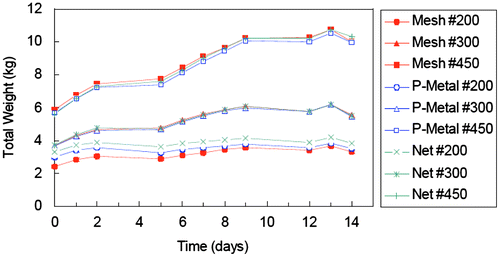
2.3. Test model experiment
2.3.1. Material and method
As the next step to the basic experiment, a test model was produced. The reactor size was 450 mm (width) × 900 mm(length) × 900 mm(height), the reactor wall was made of wire-mesh, and mixing was done by rotating the whole reactor around a rotating shaft introduced through the center of the reactor. The trial machine (test model) was placed in a laboratory. In the first two weeks of the experiment, model garbage (dog food) was input, but after that real garbage discharged from a company cafeteria was used. Thus, the contents or composition of the garbage fluctuated day by day; only input weight (wet basis) remained at a constant value. The standard garbage input was 6 kg-wet/day (=volumetric organic loading of 50 g-wet/L-reactor/day), and input of 8–12 kg/L/day was tried as a high loading test at the final stage of the experiment.
2.3.2. Result and discussion
The experiment using the test model was continued for about three months. The time course of the total input (accumulated amount of garbage input) and the total weight of the machine (test model) was shown in Figure , in which the difference between both values represented the accumulated decomposition amount of the input garbage. As shown clearly in Figure , the total weight of the reactor kept almost constant during the experimental period of about 100 days, although the total input of the garbage was over about 400 kg-wet, meaning that almost all of the garbage input was decomposed biologically into CO2 and H2O. The initial moisture content in the reactor was rather high (about 60–70%), but decreased to 30–40%, naturally, not by simple natural evaporation but by the heat generated with the aerobic microbial oxidation of organic substances in the garbage. Thus, the total reduction of the reactor weight was the sum of the disappearance of organic matter by microbial oxidation and the loss of moisture in the heap and the garbage. The total input was 437.4 kg whereas total reduction of the weight was 421.7 kg, indicating that the overall weight reduction rate was up to 95.3%. Temperature began to rise from the third day of the experiment and was kept over 40°C during the whole period (often over 60°C). Moisture content in the reactor was almost constant, even though there was no artificial control (=sensor or some kind of mechanical control), and also pH and total cell number rose up to the ideal regions naturally with the progress of the time (data not shown). One of the most important features of the static type was very small emission of bad smell. Only a delicate must or soil-like smell was felt in the reactor, but there was some smell around the garbage treatment system according to human judgment; therefore, there was no need to operate deodorizing equipment, which was often an indispensable item for the conventional type of garbage treatment system. The static type showed a large advantage in this point.
An overloading test was tried to perform at the final stage of experiment (after day 90). At that time, the total weight increased, as shown in Figure and bad smell generation was monitored, even in the static type, which was a bad sign of upset condition in the reactor. However, this unfavorable situation improved after one week of no garbage input, meaning that this system had a capability to recover from upset condition without any support. In contrast, almost all garbage treating systems, in particular the conventional type, could hardly have this kind of capability, i.e. little decrease in weight as well as bad smell generation would continue after long stop of garbage input. Therefore, it should be emphasized that the static type of garbage treating system has an excellent capability of recovery from overloading conditions. After the indoor experiment stated above, an outdoor experiment using the same model with the same input condition was performed for about three months (from December to February, the coldest season in Japan). We had concerns about the harshness for the micro-organisms in the reactor, because ambient temperature often fell to below freezing point. But, the performance of the garbage treatment was almost similar to the result shown in Figure (data not shown). In this case the overall weight reduction rate was about 93%, a little worse than that of the indoor experiment (95.3%). In the cold season, an electrical heater was used so that the temperature in the reactor was kept over 10°C. Since the major energy consumption in this system was heating electricity in the cold period, little energy consumption was maintained in warm seasons.
3. Search for the mechanism of the performance of the static type garbage treatment
3.1. What is the problem?
As shown above, the static type of garbage treating system has several excellent characteristics with no doubt. The problem is, however, the reason why this type of the treating system showed a better performance than the conventional type one has not been clarified yet. Example data are shown in Figure of the time course of garbage decomposition rate at the point of 6 h and 24 h after feed and colony number in the residue sampled at the time of feeding. There was no relation observed between the decomposition rate and the colony number.
Figure 5. An example of the time course of garbage decomposition rate and the colony number in the static type treating system.
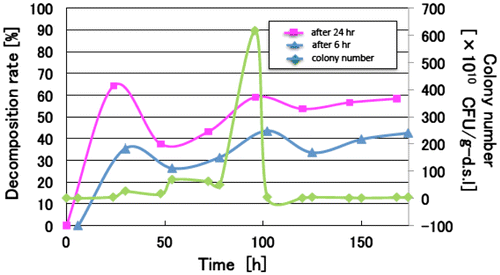
In other cases as well, no clear correlation between the performance of garbage treatment and the total colony number counted on usual agar media has not been observed so far. Possible explanations are as follows: (1) Only specific micro-organisms function effectively in the garbage treating process, (2) so called “non-culturable” micro-organisms may exist and contribute to the decomposition process (Konagai & Matsuda, Citation2016), and (3) more appropriate culture media should be selected.
3.2. A trial of the direct observation of micro-organisms in the garbage treating residue
3.2.1. Material and method
Three methods of fluorescence observation with different principles were used, as shown in Table . The sample solution mounted on a slide glass was subjected to fluorescence observation. “Fining sample” was prepared as follows. Colonies of microbes in the garbage residue grown on solid T medium were collected and cultivated in liquid T medium at 60°C for 4 h. Thus, this sample consists essentially of culturable micro-organisms without any suspended solids. “Suspension sample”: three grams of garbage residue were added with sterile water and homogenized for 10 min. Thus, this sample contains all kinds of micro-organisms living in the garbage residue and suspended solid impurities. Colony counting was done by a normal method in which nutrient-rich T and LB medium and water extracted from garbage residue were adopted to count the number of colonies grown on the culture plate.
Table 2. The methods of fluorescence observation and their conditions
3.2.2. Result and discussion
In the case of the fining sample, the total numbers measured by the fluorescence observation and the usual colony counting were almost the same as that shown in Figure , indicating the reliability of the observation methods. But in the case of the suspension sample, the total numbers detected by fluorescence observations were generally less than that by normal colony counting, although the tendency of number change was the same, as shown in Figure . This result suggested the difficulty of the direct observation of micro-organisms in the real residue of garbage treatment, which contains various soluble and solid impurities that might affect the result of fluorescence observation.
3.3. DGGE analysis
The DGGE analysis was tried using the real garbage treating residue at the point of 24 h after fresh feed. The result was shown in Figure , in which three major phases in the experimental period were observed, i.e. days 3–5 (band a–c), days 7–10 (band d–g), and after day 11 (band h–j). There were several bands detected throughout the experiment whereas many bands appeared at a specific period of time. Although the detection by DGGE was successfully performed on the real garbage treating sample, so far, no clear correlation between the behavior of the bands and colony number or the performance of the garbage treatment was not observed. Since the subject of the DGGE analysis was the total DNA extracted from the garbage residue, it was impossible to distinguish the state of microbes (dead and alive), nor identify the real effective micro-organisms in the static type of garbage treatment system (Aoshima et al., Citation2001; Hemmi, Shimoyama, Nakayama, Hoshi, & Nishino, Citation2004). Thus, other approaches would be needed for more a detailed analysis of the microbial ecosystem of the garbage treating system, for instance an analysis of metabolic functions for individual micro-organism.
4. Conclusions
It was proved by our repeated experiments with various kinds, scales and time periods that the static type of garbage treating system, in which the materials with good breathability were used for reactor walls, and mixing operation was done only when the garbage was input (usually once or twice a day), showed a much better performance than the conventional type of garbage treatment system, in which continuous internal mixing with forced ventilation were adopted and materials with no breathability were used for reactor walls. The advantages of the static type compared to the conventional ones were as follows: higher decomposition rate of the garbage, smaller generation of bad smell, better recovery performance from upset situations of overloading, simpler structures with lower manufacturing cost, and smaller consumption of energy. We believe that this system will bring a large contribution to the garbage waste problems and to the construction of a sustainable society. There are, however, many unsolved problems remaining as to why this system can exercise an excellent performance, in particular from the stand point of the analysis of the microbial ecosystem.
Funding
The authors received no direct funding for this research.
Additional information
Notes on contributors
S. Matsuda
1978 Bachelor of Chemical Engineering, Kyoto University.
1983 Dr. of Chemical Environmental Engineering, Tokyo Institute of Technology.
1983 Res. Assoc., Tokyo Institute of Technology.
1992 Assoc. Prof., Faculty of Engineering, Shizuoka University.
Major Research Area: Waste Treatment Technologies using Microorganisms; e.g. methane fermentation, composting of kitchen waste. Technology Assessment (mainly renewable energies). Life Cycle Analysis (mainly technologies for recycling of wastes).
References
- Agnew, J. M., & Leonard, J. J. (2003). The physical properties of compost. Compost Science & Utilization, 11, 238–264.10.1080/1065657X.2003.10702132
- Ahn, H. K., Richard, T. L., & Glanville, T. D. (2008). Laboratory determination of compost physical parameters for modelling of airflow characteristics. Waste Management, 28, 660–670.10.1016/j.wasman.2007.04.008
- Ahn, H. K., Sauer, T. J., Richard, T. L., & Glanville, T. D. (2009). Determination of thermal properties of composting bulking materials. Bioresource Technology, 100, 3974–3981.10.1016/j.biortech.2008.11.056
- Aoshima, M., Pedro, M. S., Haruta, S., Ding, L., Fukada, T., Kigawa, A., … Igarashi, Y. (2001). Analysis of microbial community within a composter operated using household garbage with special reference to the addition of soybean oil. Journal of Bioscience and Bioengineering, 91, 456–461.10.1016/S1389-1723(01)80273-5
- Golueke, C. G. (1972). Composting a study of the process and its principles. Emmaus: Rodale Press.
- Hemmi, H., Shimoyama, T., Nakayama, T., Hoshi, K., & Nishino, T. (2004). Molecular biological analysis of microflora in a garbage treatment process under thermoacidophilic conditions. Journal of Bioscience and Bioengineering, 97, 119–126.10.1016/S1389-1723(04)70178-4
- Karnchanawong, S., & Suriyanon, N. (2011). Household organic waste composting using bins with different types of passive aeration. Resources, Conservation and Recycling, 55, 548–553.10.1016/j.resconrec.2011.01.006
- Kasinski, S., Slota, M., Markowski, M., & Kaminska, A. (2016). Municipal waste stabilization in a reactor with an integrated active and passive aeration system. Waste Management, 50, 31–38.10.1016/j.wasman.2016.02.012
- Kasinski, S., & Wojnowska-Baryla, I. (2013). Passive aeration allows stabilization of waste without regulation of moisture. Compost Science & Utilization, 21, 147–155.10.1080/1065657X.2013.859530
- Konagai, K., & Matsuda, S. (2016). A search for effective microorganisms in garbage treatment. JJAP Conference Proceedings, 4, 011404.
- Matsuda, S., Arai, K., & Muro, G. (2006). Development of ecological garbage treating system (pp. 449–455). Proceedings of 5th international conference on global research and education, Iasi, Romania.
- Matsuda, S., Iwata, R., & Uhara, Y. (2012). Development of an effective and ecological garbage treating system. Journal of Advanced Research in Physics, 3, 1–6.
- Matsuda, S., Sugita, S., Kinoshita, K., & Amakata, M. (2002). The development of garbage treating system without electricity. Journal of Chemical Industry and Engineering China, 53, 97–98.
- Ogunwande, G. A., & Osunade, J. A. (2011). Passive aeration composting of chicken litter: effects of aeration pipe orientation and peroration size on losses of compost elements. Journal of Environmental Management, 92, 85–91.10.1016/j.jenvman.2010.08.026
- Suzuki, S. (1984). Rural refuse composting plant. Journal of Irrigation Engineering and Rural Planning, 5, 48–56.

